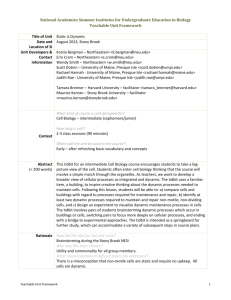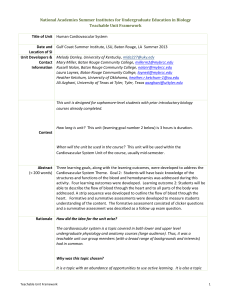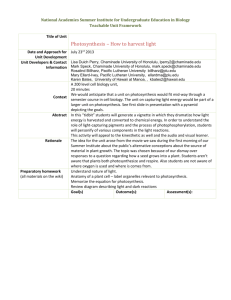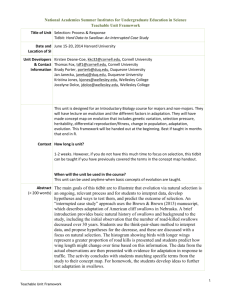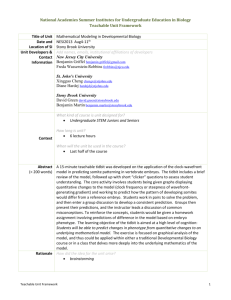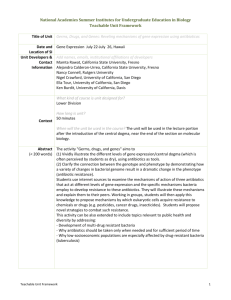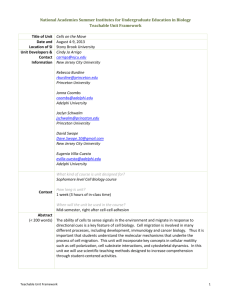Problem of Scale in Evolution (framework) Gulf Coast 2013
advertisement
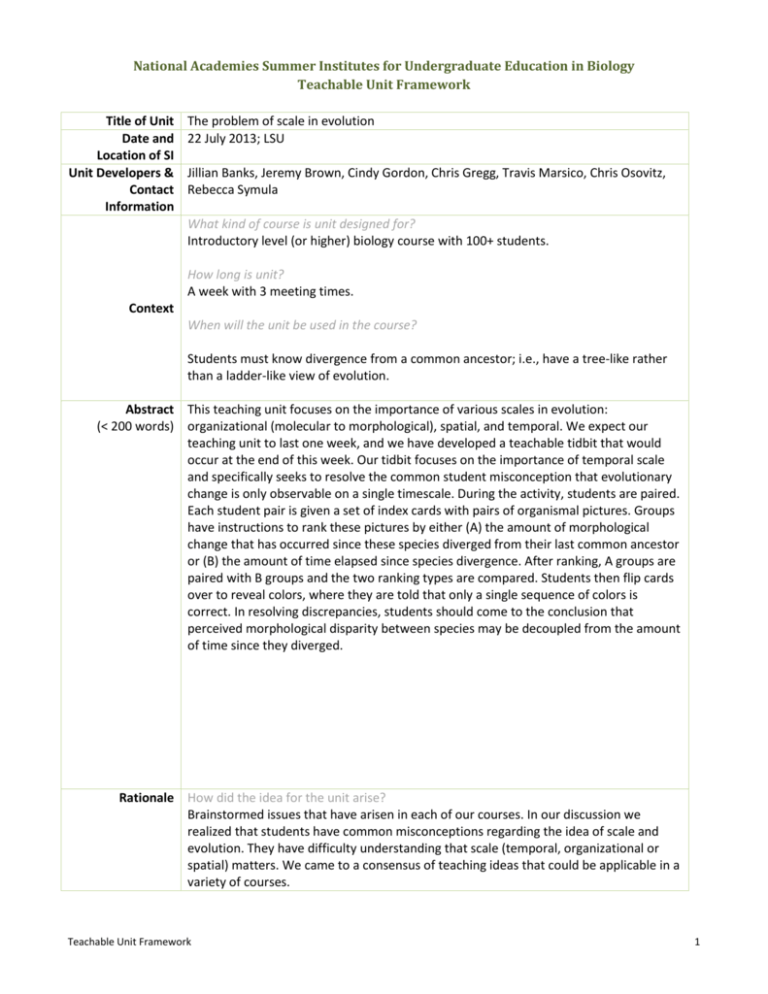
National Academies Summer Institutes for Undergraduate Education in Biology Teachable Unit Framework Title of Unit Date and Location of SI Unit Developers & Contact Information The problem of scale in evolution 22 July 2013; LSU Jillian Banks, Jeremy Brown, Cindy Gordon, Chris Gregg, Travis Marsico, Chris Osovitz, Rebecca Symula What kind of course is unit designed for? Introductory level (or higher) biology course with 100+ students. How long is unit? A week with 3 meeting times. Context When will the unit be used in the course? Students must know divergence from a common ancestor; i.e., have a tree-like rather than a ladder-like view of evolution. Abstract This teaching unit focuses on the importance of various scales in evolution: (< 200 words) organizational (molecular to morphological), spatial, and temporal. We expect our teaching unit to last one week, and we have developed a teachable tidbit that would occur at the end of this week. Our tidbit focuses on the importance of temporal scale and specifically seeks to resolve the common student misconception that evolutionary change is only observable on a single timescale. During the activity, students are paired. Each student pair is given a set of index cards with pairs of organismal pictures. Groups have instructions to rank these pictures by either (A) the amount of morphological change that has occurred since these species diverged from their last common ancestor or (B) the amount of time elapsed since species divergence. After ranking, A groups are paired with B groups and the two ranking types are compared. Students then flip cards over to reveal colors, where they are told that only a single sequence of colors is correct. In resolving discrepancies, students should come to the conclusion that perceived morphological disparity between species may be decoupled from the amount of time since they diverged. Rationale How did the idea for the unit arise? Brainstormed issues that have arisen in each of our courses. In our discussion we realized that students have common misconceptions regarding the idea of scale and evolution. They have difficulty understanding that scale (temporal, organizational or spatial) matters. We came to a consensus of teaching ideas that could be applicable in a variety of courses. Teachable Unit Framework 1 National Academies Summer Institutes for Undergraduate Education in Biology Teachable Unit Framework Why was this topic chosen? Evolution is a unifying theme in biology. Student misconceptions then have a tendency to be reinforced again and again if they are not addressed in multiple courses. Learning Goals: what students will know, understand, and be able to do; includes content knowledge, attitudes, & skills Learning Outcomes: Student behaviors or performances that will indicate they have successfully accomplished the goals What misconceptions or difficult topics are addressed? Different scales are unrelated. Evolution occurs at a single time scale. Scale is an important part of understanding evolution. There are different types of scale: temporal, spatial, and organizational scale. Evolution occurs at difference rates. Selective pressures vary over space. The cycle of variation generated at the molecular level is expressed at the organismal level. Selection acts on the phenotype (organism level) to influence allele frequency (molecular level). Apply this to modern events (climate change, GMOs, e.g.); having a context for life on Earth; the ability to synthesize information; the ability to integrate across disciplines. Students will recognize that species are not uniform. Students will recognize environmental differences across space result in different selective pressures. Students will compare and contrast phenotype at different organizational scales. Students will resolve the misconception that evolution happens at a single time scale. Students will evaluate pop culture norms and news headlines regarding how scale in evolution is portrayed. Students will generate hypotheses about the influence of scale on evolutionary process. Incorporation of Scientific Teaching Themes Active Learning How students will engage actively in learning the concepts Teachable Unit Framework Assessment How teachers will measure learning; how students will selfevaluate learning Diversity How the unit is designed to include participants with a variety of experiences, abilities, and characteristics 2 National Academies Summer Institutes for Undergraduate Education in Biology Teachable Unit Framework Activities outside of class: Pre-assessments: Read assigned material. Clicker preview over assigned reading material: Activities in class: Introduce idea of scale and evolution. Active tidbit on temporal scale and morphological change. Activities during tidbit: Organize students into pairs. Hand half the of the groups packet of cards with images – packet A (changes based on morphology) and the other packet B (changes based on time). Students will rank their cards (strip sequence). Group A students and Group B students get together to compare and discuss rankings (jigsaw). 1) How long would you expect it to take for diverging populations to display morphological variation? The activity targets introductory level biology students in a large (>100) course, and can be scaled up or down to engage lower or upper level students. Group work (strip sequence, jigsaw) will allow the incorporation of multiple perspectives into the discussion. Post-tidbit assessments: TPS – Discuss discrepancy (if so) between group A and B rankings. Clicker Review: 1) How long would you expect it to take for diverging populations to display morphological variation? Small group sizes will allow students who may be intimidated by large group discussions to become more involved. Color index cards are used, and cards with different patterns could be used to address visual impairments. Sample Presentation Plan (general schedule with approximate timing for unit) Session 1 – Time, morphology, scale tidbit Time (min) Learning Outcome(s) Teachable Unit Framework Activity/assessment Explanation, notes, suggestions, 3 National Academies Summer Institutes for Undergraduate Education in Biology Teachable Unit Framework Preclass Students will resolve the misconception that evolution happens at a single time scale. 2 hrs. Teachable Unit Framework - 3” x 5” Index cards – white (5 per group), color (5 cards per group, each card a different color) - Printed paired images reflecting various combinations of divergence time and degree of morphological difference (e.g. wolf and domestic dog, human and sea turtle, etc), small enough to fit 1 pair of images per card - glue stick and scissors - Printed instructions for Group A (morphology) and Group B (time) tips For each group of cards: - Glue a white card to each color card, so that one side is white and one side is colored (=activity card). - Choose a single color to be the instruction card in each group, and glue the printed instructions to the white side of the card (=instruction card). - Choose a sequence of colors for the activity cards (e.g. pink = 1, green = 2…the sequence is arbitrary on which color is first or second, etc). - Now, generate the sequence of images for both groups: First, rank Group A images from most similar morphology to least similar (e.g. 1 = most similar morphology, 4 = least similar morphology). Next, for the Group B images, assess the relative amount of time that has passed since the divergence of the two species on each image. Rank Group B images from most recent divergence to oldest divergence (e.g. 1 = most recent divergence, 4 = most ancient divergence). - Now glue the images ranked #1 in both groups (I.e. most morphologically similar images for group A and most recent divergence for group B) to the white side of the color card you’ve ranked #1 (e.g. pink in our example). Continue to glue the ranked images to the white side of the remainder of the ranked colors (e.g. image #2 pasted to color #2, image #3 pasted to color #3, etc.). - At this point, you should have an instruction card and a set of 4 National Academies Summer Institutes for Undergraduate Education in Biology Teachable Unit Framework Enter approx. class time for learning activity preparatory material presentation Enter approx. class time for learning activity #1 Teachable Unit Framework 5 min. 15 min. four activity cards for both group A and group B, where there is a pair of images on the white side of each card. The color of each card should only be visible once turned over. - It is recommended to write the letter “A” on the color side of all the A group cards, and write “B” on the color side of all the B activity cards to keep the cards organized. - The introduction for this activity is intended to be very brief. Simply introduce that this activity will deal with the idea of evolutionary time, and pose preassessment clicker question. Then describe the instructions for the activity, and then pass out the cards (described below). It might be advisable to pre-arrange your students in rows/groups, depending on classroom layout. - Verbal instructions for students: Before you pass out the materials, explain that the students will need to pair up and follow their specific instructions on their instruction card. - Pass out the cards and monitor progress. (5 minutes) - Once they’ve mostly finished their rankings, get the class’ attention again. Explain now that every A group needs to pair up with a B group. (You may want to notify the students that the two groups have differing instructions.) Have them compare and contrast their rankings and discuss any discrepancies. (2 minutes) - Gain the students attention again, and have them flip over 5 National Academies Summer Institutes for Undergraduate Education in Biology Teachable Unit Framework their cards, preserving both groups’ rankings. Explain that there is only one correct color ranking that applies to both groups. Have them discuss. (3 minutes) Enter approximate time for additional learning activities and associated NA class Work/preparatory materials Enter approximate time for post-activity 10 min. summing up or transition - Elicit discussion outcomes from groups. Engage the class in this discussion. - Show correct answers in powerpoint slides, beginning with most recent divergent pair (in our example, it is a dog/wolf pair). Discuss similarities and differences between the images on each slide with students. Continue though to the slide with most ancient divergence (in our example, it is the moss comparison). - Show and discuss the final composite answer slide (I.e. the slide with both morphology and divergence image ranks and the color rankings). - Pose post-assessment clicker question and discuss how student perceptions may have changed. Explicitly emphasize central learning outcome. Add additional activities information as needed for the unit. Resources for Teaching the Unit See supplemental files. Also, see below for tips. Teachable Unit Framework 6 National Academies Summer Institutes for Undergraduate Education in Biology Teachable Unit Framework Tips: Preclass activity preparation: Image pairs should (at minimum) represent the following: similar morphology + recent common ancestor; similar morphology + divergent (ancient) common ancestor; divergent morphology + recent common ancestor; divergent morphology + divergent (ancient) common ancestor Timetree.org—a website that uses NCBI genetic data to estimate divergence between two taxa. Color blind students may have difficulty distinguishing your color choices, so you may wish to use patterns on your activity cards instead (or in addition). In class background before activity: Make sure to NOT mention learning outcome before the activity begins; in this instance the “aha” effect of the activity is supposed to guide the students to the intended outcome. Instructors should ASK the students what the learning outcome is at the end of the activity. Make sure students are clear on instructions before handing out cards because students stop listening once the materials are in their hands. During activity: NOTE: It is much more difficult for Group B (that is supposed to rank by evolutionary time) to come up with an appropriate ranking than it is for the morphology group. Sometimes the students get frustrated, wanting to know geographic distributions, habitats, etc. of the organisms they are trying to rank. The instructor can provide some information, but the students should be encouraged to use some of the features they see or what they already know about diversity to complete their ranking. The frustration students feel is often beneficial (i.e., a desirable difficulty) because they are comparing what they know and struggling to make sense. This becomes important when they work with the ‘A’ (morphology) group. Before revealing correct answers, discuss with students which ranking was more difficult to do and why it was more difficult. Post-activity: Instructors should feel free to develop other activities for different types of scale. Effectiveness of unit (if you have used it in your own teaching) N/A Teachable Unit Framework 7 National Academies Summer Institutes for Undergraduate Education in Biology Teachable Unit Framework Acknowledgements (Facilitators, others who gave input, information, etc.) Rebecca Symula (facilitator) Chris Gregg (facilitator) Participants of the Gulf Coast Summer Institute (LSU), 2013 Teachable Unit Framework 8



